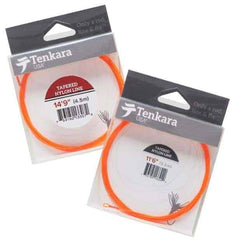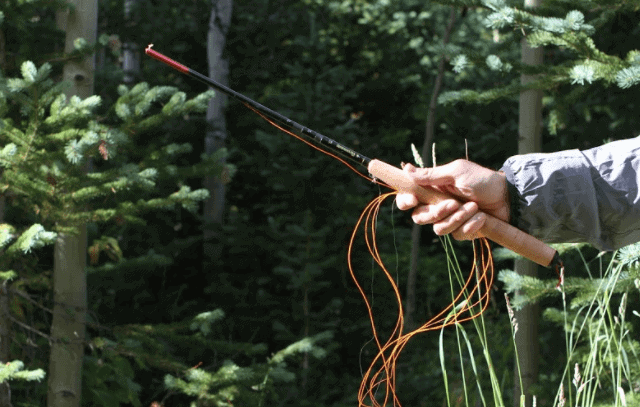Written by John Geer
One of the most common questions we get at Tenkara USA is, “What is the difference between the kinds of lines for my tenkara rod?” or at least some variation on that theme. First off, I want to say that line choice is largely a matter of personal preference. There aren’t a lot of situations where one tenkara line will work and another absolutely won’t, but they all have their strengths and weaknesses. I’d like to discuss our different options, what I like about each, and why you may want to use one over the other.
Tapered Nylon Lines

I’ll start with the tapered nylon lines. These are probably the lines most of our customers start with, as they’re what comes with our starter kit. There are good reasons for that. The tapered nylon lines offer a lot of features that make things easy for new tenkara anglers. First, the nature of a tapered line makes the transition of energy to turn the line over a bit smoother. They’re just a pretty easy line to cast. Second, the loop on the back of the line makes them easy to attach to the Lillian of the rod. Finally, the bright orange color makes them the easiest of all of our lines to see on the water. They also show up better in photographs than our other lines, although that’s not really a fishing advantage. They’re in the middle of the spectrum of how much they weigh, so they’re pretty easy to hold off of the water for good drifts.
There are a couple of downsides to the nylon lines. First, they’re only somewhat adjustable. You buy the line at a specific length and usually fish it at that length. You can cut the line back up to about 18 inches from the tip before you start to get into the taper of the line, but it’s best not to go any further than that. Also, nylon lines do have “memory,” like a nylon tapered leader used in western fly fishing. When the line comes off of the keeper or spool, it will have some memory and need to be stretched or drawn through the hand to straighten it. I’m not sure if this is a common issue, but I have seen the bright colors spook fish in very clear water.
We sell tapered nylon lines in 11’6” and 14’9”. The shorter line is usually the choice on smaller streams, the 14’9” is great on larger rivers and still waters. Either will cast fine on any of the rods we sell, but if you wish to hold all of the lines off of the water when fishing in classic tenkara fashion, you’ll want to use a line not much more than a foot or two longer than the rod you’re fishing.
Level Lines

Level lines are often the choice of tenkara anglers looking to make the most of the “tenkara advantage.” Level lines, especially the 3.5-level line we sell, are the easiest of all of our lines to hold off of the water. This allows you to effectively fish a longer line than you could with either of our tapered line options. This and the fact that our level lines come on a 65-foot spool to be cut and fished in any length desired by the angler make them the most versatile line choice. One of those 65-foot spools could easily last an angler for many seasons. They come in a bright orange color, so they’re easy to see but not quite as vivid as the tapered nylon lines.
Casting the level lines can be tricky for new tenkara anglers. Because of their light weight and lack of taper, your timing and power application need to be more spot on. This can be especially frustrating for anglers transitioning to tenkara from western fly fishing. Once these issues are sorted out, many tenkara anglers find the dense fluorocarbon construction of the level lines allows them to cut through the air (and wind) easier than any other of our lines. You do have to play by their rules, though. They will have similar memory issues to the tapered nylon lines, so plan on straightening them out after taking them off of your spool. Since the lines come uncut on the 65-foot spool, the setup is more involved. You’ll need to create the connections to both the Lillian and the stopper knot at the end of the line for the tippet. Level lines aren’t the best choice for people that are “knot-phobic.”
We offer the level lines in a 3.5 and 4.5 weight (which has no connection to the weights of western fly lines you may have seen labeled similarly). All are in bright orange color. As stated earlier, they come on a 65-foot spool and can be cut to the angler’s preference, usually about the length of the rod but up to twice that length if you have a good reason for it.
Furled Tapered Lines

The furled tapered lines are probably our easiest lines to cast. Their tapered construction and supple weight make turning over the line, tippet, and fly almost effortless with a bit of practice. That same suppleness also makes them a dream to handle, as they have essentially no memory. If you’ve fished the other lines and absolutely hate straightening them out, this is the line for you. For me, the furled lines lie out flatter and turn over a longer tippet than any of our other lines. That, mixed with their muted color, seems to make them the least likely of all of our lines to spook fish. With the loop on the back end and the tippet ring on the front, they’re the easiest of all of our lines to set up. When I take western fly fishing friends out to try tenkara for the first time, the furled lines are usually their favorite, often to the point of them thinking I’m crazy for fishing anything else.
On the downside, the furled lines can’t really be adjusted. You fish them at the purchased length and work with that. They’re also our heaviest option, so they can be more difficult to hold off of the water for the full “tenkara advantage.” If you wish to fish them that way, it’s best to stick with rods that are about as long or longer than the line being fished. Also, furled lines can snarl when popped free from a snag. The kevlar construction of our current lines is much better in that regard than the earlier nylon options we offered, but it can still happen.
We offer the furled tapered lines in lengths of 9 feet, 11 feet, and 13 feet. All are made from furled kevlar line and are in a nice muted tan color. All of our furled lines now come with a tippet ring installed at the end of the line for easy attachment of the tippet.
What’s my favorite?
For a long time, I would always answer “level lines” to this question. I still think they’re the most versatile since I can set the length to whatever I want. They’re the easiest to hold off of the water, which for me, makes them the most productive anytime I’m fishing sub-surface. Having said that, I would hate to give up the furled lines for the lovely handling and casting qualities they offer, especially if I’m fishing for spooky fish or using western dry flies. They’ve also become my favorite for sight fishing on ponds and other still waters. If I could only fish one style of line, it might be the tapered nylon lines since they combine a lot of the properties of the other two lines. Since I don’t have to do that, I usually go with the level lines or furled lines, depending on the situation and my mood. The Tenkara USA staff is split on their favorites, so we may do a follow-up to this where they can all discuss their own preferences.
As I said earlier, line choice is largely a matter of personal preference. I know excellent tenkara anglers that fish all of the above. I hope this helps answer some of your questions about lines. Best of luck figuring out what works best for you, and please feel free to contact us at info@tenkarausa.com if you have any questions about lines or any of our other products.
